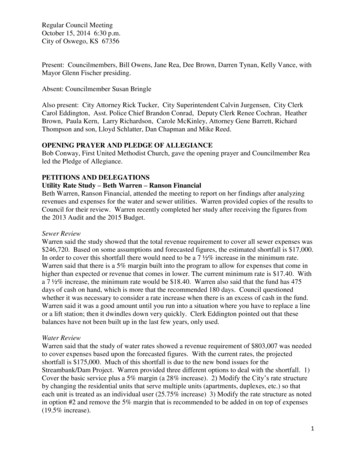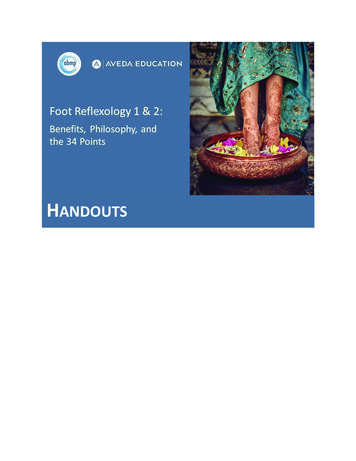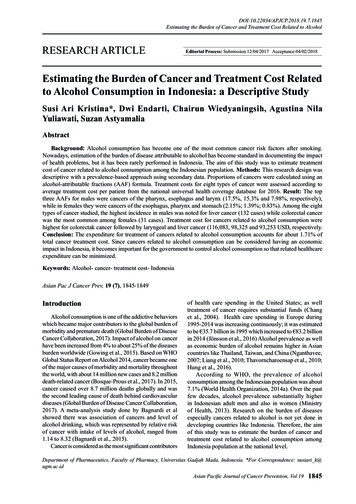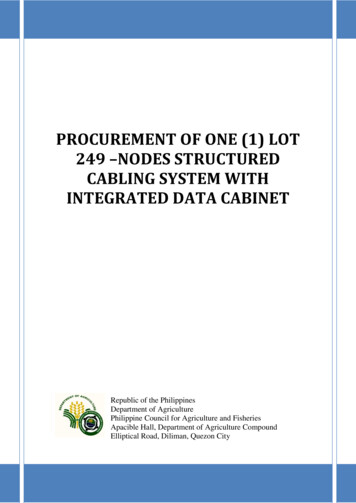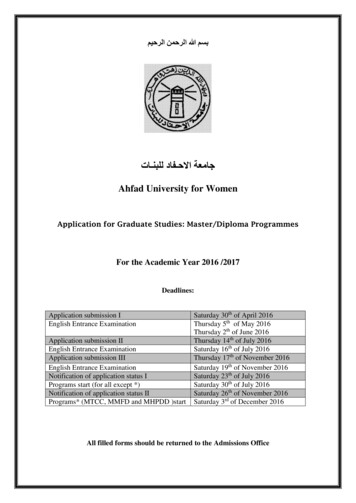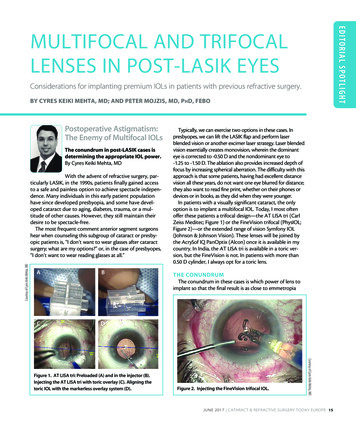
Transcription
Measure #249 (NQF 1854): Barrett’s Esophagus – National Quality Strategy Domain: EffectiveClinical Care2016 PQRS OPTIONS FOR INDIVIDUAL MEASURES:CLAIMS, REGISTRYDESCRIPTION:Percentage of esophageal biopsy reports that document the presence of Barrett’s mucosa that also include astatement about dysplasiaINSTRUCTIONS:This measure is to be reported each time a patient’s surgical pathology report demonstrates Barrett’s Esophagus;however, only one QDC per date of service for a patient is required. This measure may be reported by eligibleprofessionals who perform the quality actions described in the measure based on the services provided and themeasure-specific denominator coding.Measure Reporting via Claims:ICD-10-CM diagnosis codes and CPT codes are used to identify patients who are included in the measure’sdenominator. CPT Category II codes or quality-data codes are used to report the numerator of the measure.When reporting the measure via claims, submit the listed ICD-10-CM diagnosis codes, CPT codes, and theappropriate CPT Category II code OR quality-data code OR the CPT Category II code with the modifier. Themodifiers allowed for this measure are: 1P- medical reasons, 8P- reason not otherwise specified. All measurespecific coding should be reported on the claim(s) representing the eligible encounter.Measure Reporting via Registry:ICD-10-CM diagnosis codes, and CPT codes are used to identify patients who are included in the measure’sdenominator. The listed numerator options are used to report the numerator of the measure.The quality-data codes listed do not need to be submitted for registry-based submissions; however, these codes maybe submitted for those registries that utilize claims data.DENOMINATOR:All surgical pathology biopsy reports for Barrett’s EsophagusDenominator Criteria (Eligible Cases):Diagnosis for Barrett’s esophagus (ICD-10-CM): K22.70, K22.710, K22.711, K22.719ANDPatient encounter during the reporting period (CPT): 88305NUMERATOR:Esophageal biopsy report documents the presence of Barrett’s mucosa and includes a statement about dysplasiaNUMERATOR NOTE: Report quality data codes once per patient for each date-of-service.Numerator Quality-Data Coding Options for Reporting Satisfactorily:Esophageal Biopsy Reports with the Histological Finding of Barrett’s Mucosa that Contains aStatement about Dysplasia (present, absent, or indefinite and if present, contains appropriategrading)Performance Met: CPT II 3126F:Esophageal biopsy reports with the histological findingof Barrett’s mucosa that contains a statement aboutVersion 10.011/17/2015CPT only copyright 2015 American Medical Association. All rights reserved.Page 1 of 9
dysplasia (present, absent, or indefinite and if present,contains appropriate grading)OROROREsophageal Biopsy Reports with the Histological Finding of Barrett’s Mucosa that Contains aStatement about Dysplasia (present, absent, or indefinite) not Performed for Medical ReasonsAppend a modifier (1P) to Category II code 3126F to report documented circumstances that appropriatelyexclude patients from the denominatorMedical Performance Exclusion: 3126F with 1P: Documentation of medical reason(s) for not reportingthe histological finding of Barrett’s mucosa (eg,malignant neoplasm or absence of intestinalmetaplasia)If patient is not eligible for this measure because the specimen is not of esophageal origin report:Other Performance Exclusion: G8797:Specimen site other than anatomic location ofesophagusEsophageal Biopsy Reports with the Histological Finding of Barrett’s Mucosa that does not Containa Statement about Dysplasia (present, absent, or indefinite), Reason not Otherwise SpecifiedAppend a reporting modifier (8P) to CPT Category II code 3126F to report circumstances when the actiondescribed in the numerator is not performed and the reason is not otherwise specifiedPerformance Not Met: 3126F with 8P:Pathology report with the histological finding of Barrett’smucosa that does not contain a statement aboutdysplasia (present, absent, or indefinite, and if present,contains appropriate grading), reason not otherwisespecifiedRATIONALE:Endoscopy is the technique of choice used to identify suspected Barrett’s esophagus and to diagnose complicationsof GERD. Biopsy must be added to confirm the presence of Barrett’s epithelium and to evaluate for dysplasia (ACG,2005).There is a rapidly rising incidence of adenocarcinoma of the esophagus in the United States. A diagnosis of Barrett’sesophagus increases a patient’s risk for esophageal adenocarcinoma by 30 to 125 times that of people withoutBarrett’s esophagus (although this risk is still small 0.4% to 0.5% per year). Esophageal adenocarcinoma is often notcurable, partly because the disease is frequently discovered at a late stage and because treatments are not effective.A diagnosis of Barrett’s esophagus could allow for appropriate screening of at risk patients as recommended by theAmerican College of Gastroenterology.Standard endoscopy with biopsy currently is the most reliable means of establishing a diagnosis of Barrett’sesophagus. The definitive diagnosis of Barrett’s esophagus requires a pathologist’s review of an esophageal biopsy.Dysplasia is the first step in the neoplastic process, and information about dysplasia is crucial for clinical decisionmaking directing therapy. The presence and grade of dysplasia cannot be determined by routine endoscopy, andpathologist’s review of a biopsy is essential for recognition of dysplasia. Endoscopic surveillance detects curableneoplasia in patients with Barrett’s esophagus.CLINICAL RECOMMENDATION STATEMENTS:The diagnosis of Barrett’s esophagus requires systematic biopsy of the abnormal-appearing esophageal mucosa todocument intestinal metaplasia and to detect dysplasia.COPYRIGHT:Physician Performance Measures (Measures) and related data specifications developed by the College of AmericanPathologists are intended to facilitate quality improvement activities by physicians.Version 10.011/17/2015CPT only copyright 2015 American Medical Association. All rights reserved.Page 2 of 9
These Measures are intended to assist physicians in enhancing quality of care. They are designed for use by anyphysician who manages the care of a patient for a specific condition or for diagnosis or prevention. These Measuresare not clinical guidelines and do not establish a standard of medical care. The College has not tested its Measuresfor all potential applications.Measures are subject to review and may be revised or rescinded at any time by the College. They may not be alteredwithout the prior written approval of the College of American Pathologists. Measures developed by the College ofAmerican Pathologists, while copyrighted, can be reproduced and distributed, without modification, fornoncommercial purposes, e.g., use by health care providers in connection with their practices. Commercial use of theMeasures is not permitted absent a license agreement between the user and the College of American Pathologists.Commercial use is defined as the sale, license, or distribution of the Measures for commercial gain, or incorporationof the Measures into a product or service that is sold, licensed or distributed for commercial gain. The College ofAmerican Pathologists is not responsible for any harm to any party resulting from the use of these Measures.THE MEASURES ARE PROVIDED "AS IS" WITHOUT WARRANTY OF ANY KIND. 2007 and 2012 College of American Pathologists. All Rights ReservedLimited proprietary coding is contained in the Measure specifications for convenience. Users of the proprietary codesets should obtain all necessary licenses from the owners of these code sets. The College of American Pathologistsdisclaims all liability for use or accuracy of any Current Procedural Terminology (CPT ) or other coding contained inthe specifications.THE SPECIFICATIONS ARE PROVIDED “AS IS” WITHOUT WARRANTY OF ANY KIND. 2007 and 2012, College of American Pathologists. All rights reservedCPT contained in the Measures specifications is copyright 2004-2015 American Medical Association.Version 10.011/17/2015CPT only copyright 2015 American Medical Association. All rights reserved.Page 3 of 9
Version 10.011/17/2015CPT only copyright 2015 American Medical Association. All rights reserved.Page 4 of 9
Version 10.011/17/2015CPT only copyright 2015 American Medical Association. All rights reserved.Page 5 of 9
2016 Claims Individual Measure FlowPQRS #249: NQF #1854: Barrett’s EsophagusPlease refer to the specific section of the Measure Specification to identify the denominator and numeratorinformation for use in reporting this Individual Measure.1. Start with Denominator2. Check Patient Diagnosis:a. If Diagnosis of Barrett’s Esophagus as Listed in the Denominator equals No, do not include in EligiblePatient Population. Stop Processing.b. If Diagnosis of Barrett’s Esophagus as Listed in the Denominator equals Yes, proceed to checkEncounter Performed.3. Check Encounter Performed:a. If Encounter as Listed in the Denominator equals No, do not include in Eligible Patient Population. StopProcessing.b. If Encounter as Listed in the Denominator equals Yes, include in the Eligible population.4. Denominator Population:a. Denominator population is all Eligible Procedures in the denominator. Denominator is represented asDenominator in the Sample Calculation listed at the end of this document. Letter d equals 8 procedures inthe sample calculation.5. Start Numerator6. Check Esophageal Biopsy Reports with the Histological Finding of Barrett’s Mucosa that Contains aStatement about Dysplasia (present, absent, or indefinite) and if Present Contains Appropriate Grading:a. If Esophageal Biopsy Reports with the Histological Finding of Barrett’s Mucosa that Contains a Statementabout Dysplasia (present, absent, or indefinite) and if Present Contains Appropriate Grading equals Yes,include in Reporting Met and Performance Met.b. Reporting Met and Performance Met letter is represented in the Reporting Rate and Performance Rate inthe Sample Calculation listed at the end of this document. Letter a equals 4 procedures in SampleCalculation.c. If Esophageal Biopsy Reports with the Histological Finding of Barrett’s Mucosa that Contains a Statementabout Dysplasia (present, absent, or indefinite) and if Present Contains Appropriate Grading equals No,proceed to Esophageal Biopsy Reports with the Histological Finding of Barrett’s Mucosa that Does NotContain a Statement about Dysplasia (present, absent, or indefinite) for Medical Reasons.Version 10.011/17/2015CPT only copyright 2015 American Medical Association. All rights reserved.Page 6 of 9
7. Check Esophageal Biopsy Reports with the Histological Finding of Barrett’s Mucosa that Does Not Contain aStatement about Dysplasia (present, absent, or indefinite) for Medical Reasons:a. If Esophageal Biopsy Reports with the Histological Finding of Barrett’s Mucosa that Does Not Contain aStatement about Dysplasia (present, absent, or indefinite) for Medical Reasons equals Yes, include inReporting Met and Performance Exclusion.b. Reporting Met and Performance Exclusion letter is represented in the Reporting Rate and PerformanceRate in the Sample Calculation listed at the end of this document. Letter b1 equals 1 procedure in theSample Calculation.c. If Esophageal Biopsy Reports with the Histological Finding of Barrett’s Mucosa that Does Not Contain aStatement about Dysplasia (present, absent, or indefinite) for Medical Reasons equals No, proceed toSpecimen Site other than Anatomic Location of Esophagus.8. Check Specimen Site other than Anatomic Location of Esophagus:a. If Specimen Site other than Anatomic Location of Esophagus equals Yes, include in reporting met andperformance exclusion.b. Reporting Met and Performance Exclusion letter is represented in the Reporting Rate and PerformanceRate in the Sample Calculation listed at the end of this document. Letter b2 equals 0 procedures in theSample Calculation.c. If Specimen Site other than Anatomic Location of Esophagus equals No, proceed to Esophageal BiopsyReports with the Histological Finding of Barrett’s Mucosa that Does Not Contain a Statement aboutDysplasia (present, absent, or indefinite), Reason Not Specified.9. Check Esophageal Biopsy Reports with the Histological Finding of Barrett’s Mucosa that Does Not Contain aStatement about Dysplasia (present, absent, or indefinite), Reason Not Specified:a. If Esophageal Biopsy Reports with the Histological Finding of Barrett’s Mucosa that Does Not Contain aStatement about Dysplasia (present, absent, or indefinite), Reason Not Specified equals Yes, include inthe Reporting Met and Performance Not Met.b. Reporting Met and Performance Not Met letter is represented in the Reporting Rate in the SampleCalculation listed at the end of this document. Letter c equals 2 procedures in the Sample Calculation.c. If Esophageal Biopsy Reports with the Histological Finding of Barrett’s Mucosa that Does Not Contain aStatement about Dysplasia (present, absent, or indefinite), Reason Not Specified equals No, proceed toReporting Not Met.10. Check Reporting Not Meta. If Reporting Not Met equals No, Quality Data Code or equivalent not reported. 1 procedure has beensubtracted from reporting numerator in the sample calculation.Version 10.011/17/2015CPT only copyright 2015 American Medical Association. All rights reserved.Page 7 of 9
2016 Registry Individual Measure FlowPQRS #249: NQF #1854: Barrett’s EsophagusPlease refer to the specific section of the Measure Specification to identify the denominator and numeratorinformation for use in reporting this Individual Measure.1. Start with Denominator2. Check Patient Diagnosis:a. If Diagnosis of Barrett’s Esophagus as Listed in the Denominator equals No, do not include in EligiblePatient Population. Stop Processing.b. If Diagnosis of Barrett’s Esophagus as Listed in the Denominator equals Yes, proceed to checkEncounter Performed.3. Check Encounter Performed:a. If Encounter as Listed in the Denominator equals No, do not include in Eligible Patient Population. StopProcessing.b. If Encounter as Listed in the Denominator equals Yes, proceed to Check Specimen Origin.4.Check Specimen origin:a. If Specimen Site other than Anatomic Location of Esophagus equals Yes, do not include in EligiblePatient Population. Stop Processing.b. If Specimen Site other than Anatomic Location of Esophagus equals No, include in the Eligiblepopulation.5. Denominator Population:a. Denominator population is all Eligible Procedures in the denominator. Denominator is represented asDenominator in the Sample Calculation listed at the end of this document. Letter d equals 8 procedures inthe sample calculation.6. Start Numerator7. Check Esophageal Biopsy Reports with the Histological Finding of Barrett’s Mucosa that Contains aStatement about Dysplasia (present, absent, or indefinite) and if Present Contains Appropriate Grading:a. If Esophageal Biopsy Reports with the Histological Finding of Barrett’s Mucosa that Contains a Statementabout Dysplasia (present, absent, or indefinite) and if Present Contains Appropriate Grading equals Yes,include in Reporting Met and Performance Met.b. Reporting Met and Performance Met letter is represented in the Reporting Rate and Performance Rate inthe Sample Calculation listed at the end of this document. Letter a equals 4 procedures in SampleCalculation.c. If Esophageal Biopsy Reports with the Histological Finding of Barrett’s Mucosa that Contains a Statementabout Dysplasia (present, absent, or indefinite) and if Present Contains Appropriate Grading equals No,proceed to Esophageal Biopsy Reports with the Histological Finding of Barrett’s Mucosa that Does NotContain a Statement about Dysplasia (present, absent, or indefinite) for Medical Reasons.Version 10.011/17/2015CPT only copyright 2015 American Medical Association. All rights reserved.Page 8 of 9
8. Check Esophageal Biopsy Reports with the Histological Finding of Barrett’s Mucosa that Does Not Contain aStatement about Dysplasia (present, absent, or indefinite) for Medical Reasons:a. If Esophageal Biopsy Reports with the Histological Finding of Barrett’s Mucosa that Does Not Contain aStatement about Dysplasia (present, absent, or indefinite) for Medical Reasons equals Yes, include inReporting Met and Performance Exclusion.b. Reporting Met and Performance Exclusion letter is represented in the Reporting Rate and PerformanceRate in the Sample Calculation listed at the end of this document. Letter b equals 1 procedure in SampleCalculation.c. If Esophageal Biopsy Reports with the Histological Finding of Barrett’s Mucosa that Does Not Contain aStatement about Dysplasia (present, absent, or indefinite) for Medical Reasons equals No, proceed toCheck Esophageal Biopsy Reports with the Histological Finding of Barrett’s Mucosa that Does NotContain a Statement about Dysplasia (present, absent, indefinite), Reason Not Specified.9. Check Esophageal Biopsy Reports with the Histological Finding of Barrett’s Mucosa that Does Not Contain aStatement about Dysplasia (present, absent, or indefinite), Reason Not Specified:a. If Esophageal Biopsy Reports with the Histological Finding of Barrett’s Mucosa that Does Not Contain aStatement about Dysplasia (present, absent, or indefinite), Reason Not Specified equals Yes, include inthe Reporting Met and Performance Not Met.b. Reporting Met and Performance Not Met letter is represented in the Reporting Rate in the SampleCalculation listed at the end of this document. Letter c equals 2 procedures in the Sample Calculation.c. If Esophageal Biopsy Reports with the Histological Finding of Barrett’s Mucosa that Does Not Contain aStatement about Dysplasia (present, absent, or indefinite), Reason Not Specified equals No, proceed toReporting Not Met.10. Check Reporting Not Meta. If Reporting Not Met equals No, Quality Data Code or equivalent not reported. 1 procedure has beensubtracted from reporting numerator in the sample calculation.Version 10.011/17/2015CPT only copyright 2015 American Medical Association. All rights reserved.Page 9 of 9
All measure-specific coding should be reported on the claim(s) representing the eligible encounter. Measure Reporting via Registry: ICD-10-CM diagnosis codes, and CPT codes are used to identify patients who are included in the measure's denominator. The listed numerator options are used to report the numerator of the measure.
